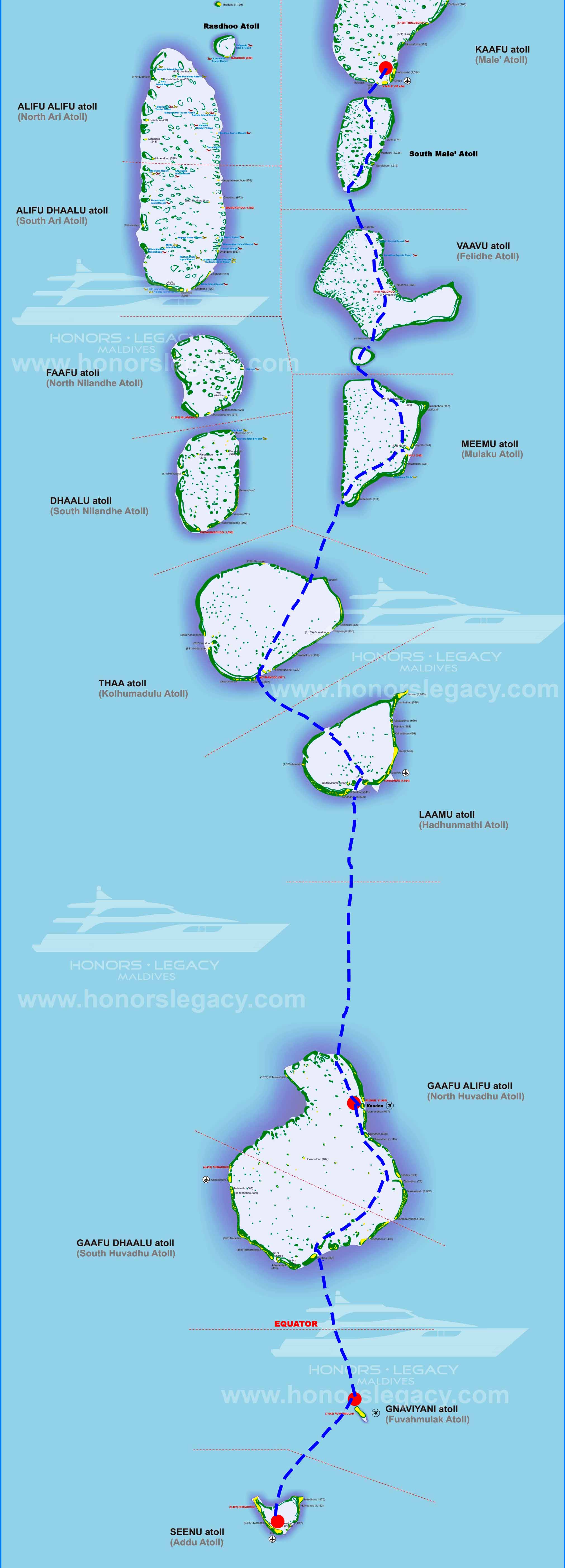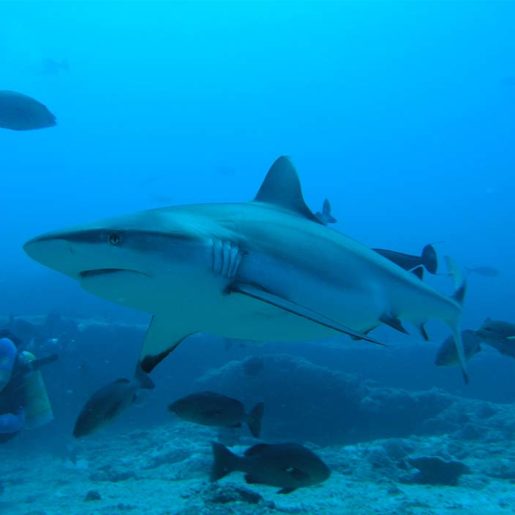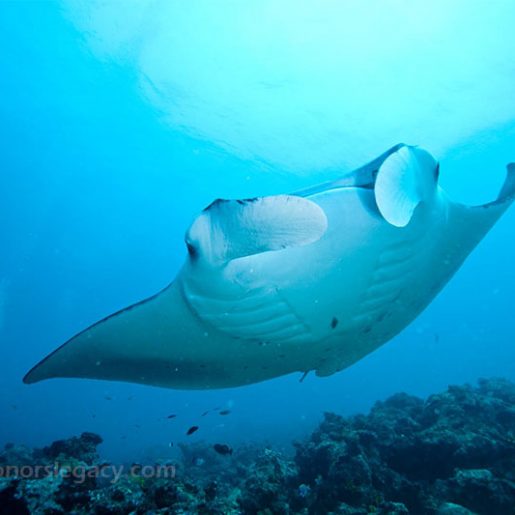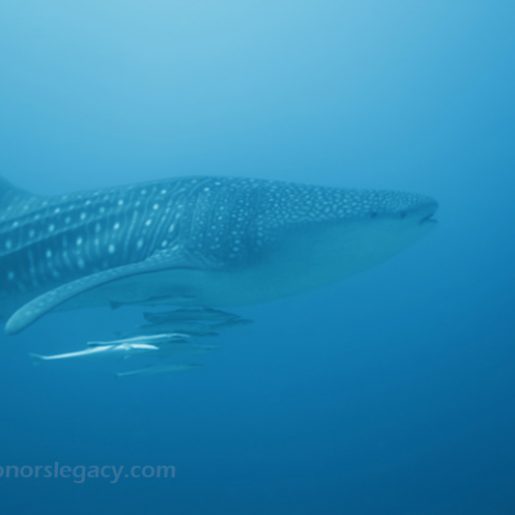ITINERARY HIGHLIGHTS
North Male Atoll
- Also known as North Kaafu, North Male is perhaps the best known and explored diving area of the Maldives, having long been recognized as providing a great variety of scuba diving, beautiful scenery and a geographical location that makes it relatively easy to get to.
- North Male Atoll diving is characterised by reefs, caves, current-swept channels and drop offs. The atoll sees plenty of fish action and is generally a good area for large pelagics, with reef sharks and mantas at the front of the queue.
South Male Atoll
- Kandus, or channels, are a major feature of South Male diving. On the eastern reef wall there are 6 channels through which a huge volume of water gushes, bringing with it all the nutrients to attract large quantities of marine life.
- Cocoa Thila is South Male’s most revered site. It is a large, deep water pinnacle on the outer edges of the atoll, its many ravines and overhangs provide divers with refuges in which to shelter from the strong currents that attract grey reef sharks, eagle rays and large schools of fusiliers. Larger reef fish can be observed too, such as sweetlips, snappers and groupers.
Vaavu Atoll:
- Vaavu Atoll boasts Fotteyo Falhu – the largest unbroken barrier reef in the Maldives. The reef is 50 km long and the easternmost point of the Maldives archipelago.
- Vaavu is mostly visited by liveaboards and this is undoubtedly the best way to explore these unspoilt sites.
- Throughout the year you can find numerous sharks in the heavy currents and there are many thrilling shark dive sites. As well as plenty of grey reef and white tip reef sharks, you may be lucky enough to see hammerhead sharks.
- Highlights include Alimatha jetty which is also becoming a hot spot for a night dive due to the nurse sharks that can be found here.
Meemu Atoll:
- Excellent Channel dives with outside walls draping in yellow soft coral and teeming with sharks.
- Also visit the famous Muli Corner for a thrilling dive with great visibility and pelagic life.
- Beautiful channels with pelagic action, Sailfish, Grey Reef Sharks, Eagle Rays and beautiful soft coral. Manta cleaning station.
Thaa Atoll:
- Thaa Atoll (also known as Kolhumadulu) is among the least visited dive destinations in the Maldives.
- This round atoll has a combined landmass close to nine kilometres, with no single island larger than a square kilometre.
- The mesmerizingly beautiful series of 66 tiny islands that make up the atoll are surrounded by spectacularly clear water with underwater wonders and beauty yet to be discovered. Some dives have strong currents but this brings in the pelagic such as Hammerheads, Whale Sharks and dolphins especially at night.
- Expect large reefs, coral gardens, steep walls and overhangs plus action packed channels.
- Advanced divers can explore deep, steep walls that are decorated with coral. Hammerhead Sharks, Whale Sharks, Dolphins, Traditional Maldivian Channel Diving.
Laamu Atoll
- Laamu Atoll (also known as Haddhunmathi Atoll) is an oval shaped southern atoll.
- It measures 48 km in length and 35 km in width, and has some of the top dive sites in the world such as Guraidhoo and Gan; this Maldives Atoll is situated 32 southeast of Kolhumandulu Atoll and 95 km north of Huvadhoo Atoll.
- Laamu Atoll boasts numerous pristine dive sites with many different features like caves, steep drop offs, swim-throughs, not to mention the abundance of marine life and beautiful topography.
- Expect beautiful fish-filled channels with great shark encounters.
- Beautiful fish filled channels with great shark encounters.
Huvadhoo Atoll (Gaafu Alif / Gaafu Dhaal)
- Huvadhoo Atoll, also known as Gaafu Atoll, is one of the southern and the deepest atoll in the Maldives. Here are numerous pristine dive sites filled with caves, steep drop offs and beautiful underwater landscapes, as well as breath-taking coral formations and fish life.
- Diving at Nilandhoo Kandu sees divers likely to face the strongest current near the entrance of the channel and the drop-off.
- Expect to see mantas, leopard sharks, grey reef sharks, silky sharks, schools of barracudas, eagle rays, schools of jacks, and turtles on the sandy bottom. Nilandhoo Kandu is popular with ‘shark trips’ and underwater photographers.
- Mareehaa Kandu is a channel dive perfect for underwater photographers wanting some macro shots. At this site divers drift the reef, wall, and look out for big fish. At the entrance of the channel it is possible to see grey reef sharks, eagle rays and trevallies. There are also schools of silversides and bluefin trevallies, as well as various shrimp and crabs near the hard corals. Hawksbill turtles and whale sharks are spotted occasionally.
- Huvadhoo Atoll: Whale Sharks, more sharks, fast channel dives in Vilingilli Kandu area
Fuvahmulah
This solitary island, also commonly called Foammulah Atoll, lies within the Equatorial Channel between Huvadhoo Atoll to the north and Addu Atoll to the south. It consists of a low lying coral formation that spans 4.5 km in length and stretches 1.2 km wide. What sets this unique atoll apart from other Maldives dive sites are the frequent sightings of thresher sharks, oceanic white tips and tiger sharks.
ADDU ATOLL
British Royalty Wreck
This 420 ft long tanker is the biggest wreck in the Maldives, torpedoed twice during WW II and eventually sunk by the British in 1946. The vessel rests on its starboard side at around 33 meters depth.
Maa Corner
The place is known for its cleaning station hosting manta rays all year long. The main station is quite deep and the current in the channel can make it more difficult to handle for beginners. There are a few coral blocks a bit shallower, which are also considered cleaning stations and mantas can be seen there quite often. Current hooks are recommended to keep the right position and stay in one place for better observation.




